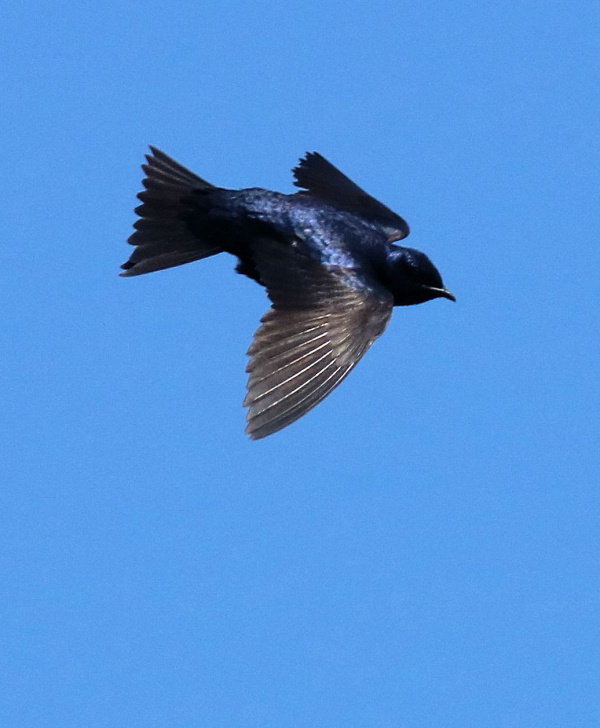
Although they nest in the United States and Canada, many Purple Martins spend most of each year in the Amazon River Basin (photo by Paul Konrad).
|
A tiny island in the midst of a Brazilian river could hold the key to the future of Purple Martins! Vast numbers of Purple Martins utilize one roost site in the heart of the Amazon to concentrate before winging their way to North American bird houses. Just 12 acres in size, or slightly larger than Yankee Stadium, the tiny island in the midst of the Rio Negro attracts a remarkable number Purple Martins, roughly 250,000 between February and April. It’s one of the largest Purple Martin roosts ever discovered, and its significance isn’t just its size, but also the pivotal role it may play in the species’ long-distance migrations.
The island – Comaru – could be the staging area or launchpad for many of the more than 9 million Purple Martins that funnel from South America to North America, and some biologists believe the overall number stopping there may be more than million Purple Martins as birds come and go.
Mario Cohn-Haft, the curator of birds at the National Institute of Amazonian Research in Manaus, Brazil believes the island could be a key to understanding the species’ population dynamics. “It is the single biggest window we have into what Purple Martins are doing in South America during winter,” he explained. The North American nesting population of Purple Martins is estimated to have decreased 25 percent since 1966, yet little is known about the challenges Purple Martins encounter when they migrate south each fall. “If we can trace their movements, figure out what they’re eating, and analyze whether they are ingesting contaminants, including pesticides and other pollutants, we can learn something about how they’re doing down here,” Mario said.
Natural cavities, such as tree hollows once provided ample nesting sites for Purple Martin nesting colonies, but the loss of most of those natural cavities, coupled with competition from aggressive non-native species like European Starlings and House Sparrows have made Purple Martins nearly 100 percent reliant on people providing housing for them to nest. As a result, Purple Martins have become valued research subjects with thousands banded at backyard nesting “apartment houses” each year. More recently, martin’s site fidelity has made them ideal for carrying tracking devices, many of which must be recovered to retrieve the information recorded.
Although Purple Martins have been extensively studied in North America, our scientific knowledge tapers off when they fly south. Just where they go, what routes they take, and what critical habitat they use along the way have largely remained a mystery. Kevin Fraser, an ornithologist at the University of Manitoba, fitted 105 Purple Martins with advanced trackers: GPS devices that logged the positions of each bird periodically over time. The 14 trackers he retrieved from tagged Purple Martins the following spring revealed that all but one overwintered in the Amazon River Basin, and 5 of them spent a lot of time near Manaus, crammed into an area no larger than a suburban home property. This information almost certainly proved the martins gathered at a roost site; and if biologists could locate it, they could begin to understand what role wintering areas and staging sites play in Purple Martins’ survival.
Then, early in 2019, Cohn-Haft heard from a student about a huge flock of birds that a local resident showed her, only 20 miles from Manaus. The local person offered to take Cohn-Haft to the location, and he realized right away that it was a roost site being used by Purple Martins; he said: “It really was just one of those absolutely goosebump-raising, heart-warming, uplifting, inspiring moments.” And he sensed immediately that the roost could provide a treasure trove of scientific information about Purple Martins in Amazonia.
There is much more to this story – literally – including interesting insights to the work being conducted at the island by biologists. To learn more, you can refer to the original Audubon article at This Tiny Brazilian Island Could Hold the Key to the Purple Martin’s Future | Audubon
And you can learn more about the Purple Martin Conservation Association, by clicking on the organization’s name here.